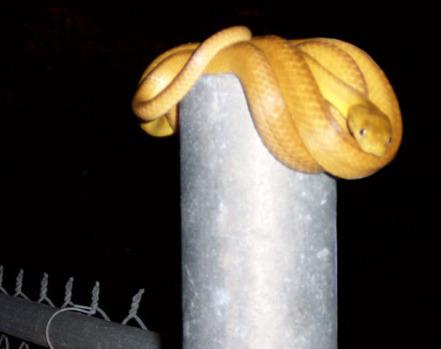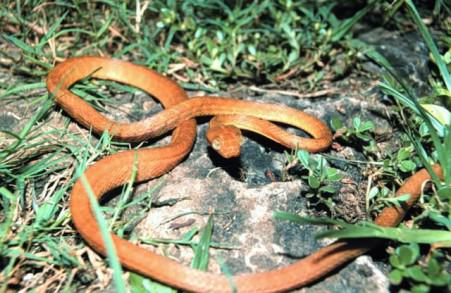For the last 60 years the Pacific island of Guam has been under invasion
from an enemy they have few defenses against. The brown tree snake is
believed to have arrived in Guam by way of military transport at the end
of World War II, most likely hitching a ride on a plane or ship as U.S.
military equipment was being removed from Papua New Guinea and
surrounding islands.
Guam had never had any species of snake prior to the arrival of the slithering reptile, leaving the island without any natural predators to help control their population and a large amount of prey that had no natural defenses. The island is small, just over 300 square miles and is now infested with 2 million snakes, making the brown tree snake the most successful invasive species in history. Compare that with the human population of the island -- fewer than 200,000.
The brown tree snake is native to the islands of Melanesia, Papua New Guinea, and some parts of Australia. The lush food supply of small birds helped boost the population numbers. Authorities had hoped that as the bird population dwindled, so would the snake population. However, the snakes just shifted their diet to include other small animals such as rodents and lizards. Ten of the twelve native bird species have vanished and the numbers of the remaining two species is seriously depleted..

The snake invaders have caused many problems. While the impact on wildlife has been the biggest impact on Guam, the island country is plagued with black outs caused by snakes crawling on power lines and getting into transformer boxes. The power outages are so frequent that people call them "brown outs" in reference to the cause. The snakes are also mildly venomous, which is of small concern to adults, but is a serious health threat to children. The economic impact as also been hefty as the snakes affect health care costs, lost production from the power outages, lost tourism and ecotourism.
The United States government and the people of Guam are waging war on the snakes. Total eradication seems to be the only option. One of the more creative methods they are using to combat the snake population is poisonous mouse bombs. This involves dropping dead mice laced with poison and fitted with tiny parachutes from helicopters. Unsuspecting snakes eat the tasty tidbit and die.
The toxin being used for these rodent drops is acetaminophen, a common over-the-counter pain reliever for humans, but deadly to snakes.
The second front on this war against the brown tree snake is to keep it from spreading to other islands in the Pacific to prevent further ecological disaster. The US government has all planes leaving Guam inspected to make sure that they are free of stowaways. To that end, they have enlisted the help of a team of small dogs. The dogs use their incredibly powerful sense of smell to go over boxes and crates of cargo to prevent the little brown serpents from escaping the island.'
At the other end of the snake eradication spectrum are islands like Hawaii that could also be decimated should the snake arrive there. Hawaii also has no native snake species and no snake predators. Eight brown snakes have been found alive or dead in Hawaii between 1981 and 1998 and all were associated with transport of goods or equipment out of Guam. These were the years when the problem had just been coming to light. There are no known brown snakes in Hawaii at the current time. The estimated cost to Hawaii if the brown tree snake was to invade approaches nearly half a billion dollars by some estimates.
Sources: BBC News, Stopping the Silent Invasion, Index Mundi

